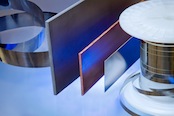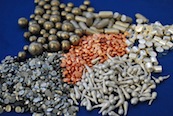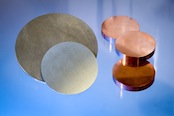Niobium Foil and Sheet
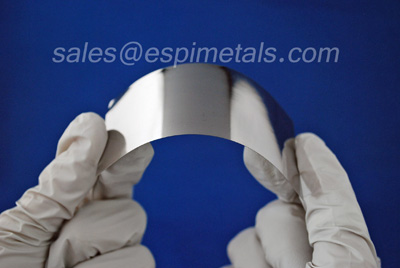 |
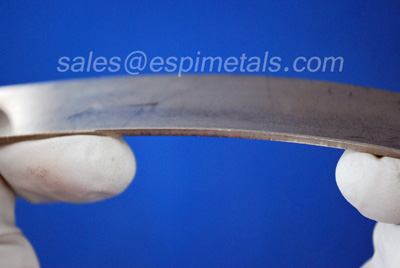 |
| NIOBIUM FOIL | NIOBIUM SHEET |
NIOBIUM - HISTORY AND USES
Niobium (Nb) at #41 on the peridodic table, is a silvery metal resistant to corrosion.
Niobium was discovered in Massachusetts in 1801, by the English chemist Charles Hatchet. Originally he named the mineral columbite and the new element columbium, after the poetic name for the United States, Columbia. Hatchett then sent a sample to a museum in England. The columbium discovered by Hatchett was probably a mixture of the new element niobium along with tantalum.
This led to a great deal of confusion since Niobium and tantalum have similar physical and chemical properties, making the two difficult to distinguish. In 1809, another English chemist, William Hyde Wollaston, incorrectly concluded that tantalum and columbium were identical. But, in 1846, German chemist, Heinrich Rose, concluded that the tantalum samples contained a second element, which he termed niobium. In the following few years, a series of scientific findings concluded that niobium and columbium were the same element (as distinguished from tantalum), and for a long period of time both terms were used interchangeably. Niobium was officially adopted as the name of the element in 1949
The main source of this element is extracted from columbite, which can be found in Northeast US, Canada, Brazil, Australia, Nigeria and elsewhere. However, it is commercially prepared as a by-product of tin extraction and the general primary source is from the pyrochlore mineral.
Niobium becomes a superconductor at cryogenic temperatures. At atmospheric pressure, it has the highest critical temperature of the elemental superconductors. Niobium has the largest magnetic penetration depth of any element. High-energy physics researchers use some electron accelerators that include chambers cast from pure or alloyed niobium. When chilled to near absolute zero, these niobium chambers become both highly magnetic and superconducting, which permits researchers to increase the speed of subatomic particles without using ever-increasing amounts of electricity. Superconductive niobium cavities are at the heart of the accelerator at the Thomas Jefferson National Accelerator Facility. This machine is used by scientists to study the quark structure of matter. The accelerator's 338 cavities bathed in liquid helium assist in accelerating electrons to nearly the speed of light.
Coating glass with a superfine niobium powder improves the glass's ability to transmit light without absorbing or refracting it. The coating also makes glass more glare-resistant. Niobium-coated glass has applications for camera lenses, along with television and computer screens. Niobium also sees use in protective coatings for ceramic capacitors.
Niobium is used as an alloying agent and for jewelry. Other uses include adding small amounts to improve stainless steel, as an alloying agent in carbon and alloy steels and in non-ferrous metals to improve strength. It is key element in manufacture of jet engines and rockets.
NIOBIUM FOIL AND NIOBIUM SHEET
In 1959 manufacturing companies develope niobium-based alloys, driven primarily from the cold war and the space race, using Vacuum Arc Re-melting (VAR) and Electron Beam Melting (EBM) techniques to produce ingot to niobium sheet production capabilities for the manufacture of high temperature turbine (jet) engine and rocket thruster engines and components, as well as, liquid metal heat exchangers. Because of it's strength and workability, very thin sheets of niobium can be clad to other surfaces, providing superior and cost effective corrosion protection.
Roughly ninety percent of Niobium is used in the production of high-grade structural steel, a great deal in the form of niobium sheet, followed by its use in supealloy for such applications as jet engine components, gas turbines, rocket subassemblies, turbo charger systems, and heat resisting and combustion equipment .
Niobium foil also sees use in protective coatings for ceramic capacitors. Other uses include: electroceramics, hypoallergenic applications, such as in medical (implant) and jewelry making and numismatics
ADDITIONAL INFORMATION ON AVAILABLE NIOBIUM PRODUCTS AND FORMS
ESPI provides high purity foil and sheet in many different elements for distribution to universities, research labs and manufacturing companies in numerous purities and form factors (i.e., wire, rod, ribbon, shot, pellets, pieces, powder, sputtering targets, discs and custom fabricated parts). We are able to fabricate all the above to your specification.
CONTACT AND ORDERING:
541.488.8311 telephone
800.638.2581 toll-free
541.488.8313 fax
800.488.0060 toll-free fax
This email address is being protected from spambots. You need JavaScript enabled to view it.
GENERAL PROPERTIES
|
Symbol: |
Nb |
|
Atomic Number: |
41 |
|
Atomic Weight: |
92.9064 |
|
Density: |
8.57 gm/cc |
|
Melting Point: |
2468 oC |
|
Boiling Point: |
4742 oC |
|
Thermal Conductivity: |
0.537 W/cm/K @ 298.2 K |
|
Electrical Resistivity: |
12.5 microhm-cm @ 0 oC |
|
Electronegativity: |
1.6 Paulings |
|
Specific Heat: |
0.064 Cal/g/K @ 25 oC |
|
Heat of Vaporization: |
- |
|
Heat of Fusion: |
6.5 Cal/gm mole |
|
|
|
|
|
|
|
|

 ALLOYS
ALLOYS 
